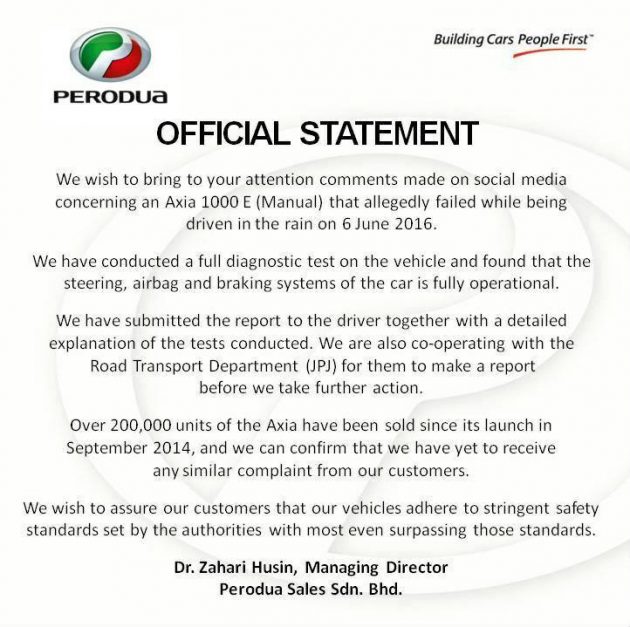Perodua has released an official statement regarding the Axia ‘steering lock’ accident that happened in Penang in June, which is making its rounds on the social media and Whatsapp.
According to the company, a full diagnostic test was made on the vehicle (an Axia E MT) following the accident, and results reveal steering, braking and airbag systems that were functioning normally. Perodua has submitted the report to the driver and is co-operating with the Road Transport Department (JPJ). The company says that it has yet to receive any complaint of this nature after selling over 200,000 units of the Axia since September 2014.
“We wish to assure our customers that our vehicles adhere to stringent safety standards set by the authorities with most even surpassing those standards,” said Dr Zahari Husin, MD of Perodua.
According to the driver involved in the accident, the accident happened in the rain and when he was driving between 70 to 80 km/h on the Second Penang Bridge. He claimed that the steering of his car suddenly ‘locked’ and could not be turned. The driver also claimed that he slammed on the brakes but it did not function, and the airbags did not deploy after the car hit the road barrier.
In Perodua’s report, the company pointed out that all four tyres of the car were bald, with three of them having just 1 mm of tread depth. The reason the airbags did not deploy in this case could be because of the weak frontal impact or that the crash impact has been absorbed by the car’s structure.
Looking to sell your car? Sell it with Carro.


















AI-generated Summary ✨
Comments largely criticize Perodua for not including ABS and VSC in the Axia, which many believe could have prevented the accident. The lack of safety features, combined with bald, worn tires and heavy rain, is seen as a significant contributor to the crash. Several commenters mention that the car's structure and impact severity suggest a more serious accident warranting airbag deployment, questioning Perodua's explanation. There is concern that the tires were in poor condition despite being used for over 80,000 km, and that the car may have hydroplaned due to insufficient tread. Many blame driver neglect and poor maintenance, while criticizing Perodua’s handling of the incident, including accusations of minimizing the crash's impact and lack of transparency. Overall, the sentiment underscores frustration over safety shortcomings and perceived corporate negligence.